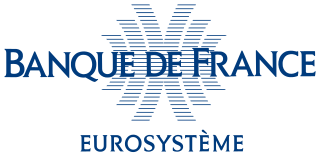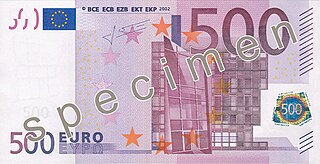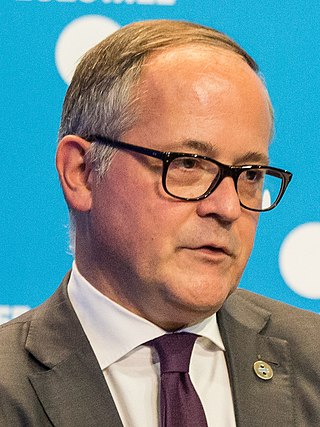Related Research Articles

A central bank, reserve bank, or monetary authority is an institution that manages the currency and monetary policy of a country or monetary union. In contrast to a commercial bank, a central bank possesses a monopoly on increasing the monetary base. Many central banks also have supervisory or regulatory powers to ensure the stability of commercial banks in their jurisdiction, to prevent bank runs, and in some cases also to enforce policies on financial consumer protection and against bank fraud, money laundering, or terrorism financing.

The euro is the official currency of 20 of the 27 member states of the European Union. This group of states is officially known as the euro area or, commonly, the eurozone, and includes about 344 million citizens as of 2023. The euro is divided into 100 euro cents.

The European Central Bank (ECB) is the prime component of the Eurosystem and the European System of Central Banks (ESCB) as well as one of seven institutions of the European Union. It is one of the world's most important central banks.

The Deutsche Bundesbank is the German member of the Eurosystem and has been the monetary authority for Germany from 1957 to 1998, issuing the Deutsche Mark (DM). It succeeded the Bank deutscher Länder, which had introduced the DM on 20 June 1948.

The European System of Central Banks (ESCB) is an institution that comprises the European Central Bank (ECB) and the national central banks (NCBs) of all 27 member states of the European Union (EU). Its objective is to ensure price stability throughout the EU, and improve monetary and financial cooperation between eurozone and non-eurozone member states of the EU.
In macroeconomics, an open market operation (OMO) is an activity by a central bank to give liquidity in its currency to a bank or a group of banks. The central bank can either buy or sell government bonds in the open market or, in what is now mostly the preferred solution, enter into a repo or secured lending transaction with a commercial bank: the central bank gives the money as a deposit for a defined period and synchronously takes an eligible asset as collateral.

The Bank of France is the French member of the Eurosystem. Napoleon Bonaparte established it in 1800 as a private-sector corporation with unique public status, and Charles de Gaulle's government nationalized it in 1945 after several governance changes in the meantime. The Bank of France was granted note-issuance monopoly in Paris in 1803 and in the entire country in 1848, issuing the French franc. It remained France's sole monetary authority until end-1998, when France adopted the euro as its currency.

The president of the European Central Bank is the head of the European Central Bank (ECB), the main institution responsible for the management of the euro and monetary policy in the Eurozone of the European Union (EU).
Helicopter money is a proposed unconventional monetary policy, sometimes suggested as an alternative to quantitative easing (QE) when the economy is in a liquidity trap. Although the original idea of helicopter money describes central banks making payments directly to individuals, economists have used the term "helicopter money" to refer to a wide range of different policy ideas, including the "permanent" monetization of budget deficits – with the additional element of attempting to shock beliefs about future inflation or nominal GDP growth, in order to change expectations. A second set of policies, closer to the original description of helicopter money, and more innovative in the context of monetary history, involves the central bank making direct transfers to the private sector financed with base money, without the direct involvement of fiscal authorities. This has also been called a citizens' dividend or a distribution of future seigniorage.

Quantitative easing (QE) is a monetary policy action where a central bank purchases predetermined amounts of government bonds or other financial assets in order to stimulate economic activity. Quantitative easing is a novel form of monetary policy that came into wide application after the financial crisis of 2007–2008. It is used to mitigate an economic recession when inflation is very low or negative, making standard monetary policy ineffective. Quantitative tightening (QT) does the opposite, where for monetary policy reasons, a central bank sells off some portion of its holdings of government bonds or other financial assets.
TARGET2 is the real-time gross settlement (RTGS) system for the Eurozone, and is available to non-Eurozone countries. It was developed by and is owned by the Eurosystem. TARGET2 is based on an integrated central technical infrastructure, called the Single Shared Platform (SSP). SSP is operated by three providing central banks: France, Germany and Italy. TARGET2 started to replace TARGET in November 2007.

Banknotes of the euro, the common currency of the eurozone, have been in circulation since the first series was issued in 2002. They are issued by the national central banks of the Eurosystem or the European Central Bank. The euro was established in 1999, but "for the first three years it was an invisible currency, used for accounting purposes only, e.g. in electronic payments". In 2002, notes and coins began to circulate. The euro rapidly took over from the former national currencies and slowly expanded around the European Union.

The five-hundred-euro note (€500) is the highest-value euro banknote; it was produced between the introduction of the euro in 2002 until 2019. Since 27 April 2019, the banknote has no longer been issued by central banks in the euro area, but it continues to be legal tender and can be used as a means of payment. It is one of the highest-value circulating banknotes in the world, worth around 537 USD; 3,902 CNY; 79,165 JPY; 430 GBP, or 479 CHF as of September 2023. The note is used in the 26 countries which have the euro as their sole currency, with a population of about 343 million.

The European Stability Mechanism (ESM) is an intergovernmental organization located in Luxembourg City, which operates under public international law for all eurozone member states having ratified a special ESM intergovernmental treaty. It was established on 27 September 2012 as a permanent firewall for the eurozone, to safeguard and provide instant access to financial assistance programmes for member states of the eurozone in financial difficulty, with a maximum lending capacity of €500 billion. It has replaced two earlier temporary EU funding programmes: the European Financial Stability Facility (EFSF) and the European Financial Stabilisation Mechanism (EFSM).

Benoît Georges Cœuré is a French economist who has been serving as President of the Autorité de la concurence since 2022. He previously served as a member of the Executive Board of the European Central Bank from 2012 to 2019.

European Banking Supervision, also known as the Single Supervisory Mechanism (SSM), is the policy framework for the prudential supervision of banks in the euro area. It is centered on the European Central Bank (ECB), whose supervisory arm is referred to as ECB Banking Supervision. EU member states outside of the euro area can also participate on a voluntary basis, as was the case of Bulgaria as of late 2023. European Banking Supervision was established by Regulation 1024/2013 of the Council, also known as the SSM Regulation, which also created its central decision-making body, the ECB Supervisory Board.

Sabine Lautenschläger is a German jurist who served as a member of the Executive Board of the European Central Bank from 2014 to 2019. She previously served as vice-president of the Deutsche Bundesbank from 2011 to 2013.
The banking union refers to the transfer of responsibility for banking policy from the national to the European Union (EU) level in several EU member states, initiated in 2012 as a response to the Eurozone crisis. The motivation for banking union was the fragility of numerous banks in the Eurozone, and the identification of a vicious circle between credit conditions for these banks and the sovereign credit of their respective home countries. In several countries, private debts arising from a property bubble were transferred to the respective sovereign as a result of banking system bailouts and government responses to slowing economies post-bubble. Conversely, weakness in sovereign credit resulted in deterioration of the balance sheet position of the banking sector, not least because of high domestic sovereign exposures of the banks.
In 2009–2010, due to substantial public and private sector debt, and "the intimate sovereign-bank linkages" the eurozone crisis impacted periphery countries. This resulted in significant financial sector instability in Europe; banks' solvency risks grew, which had direct implications for their funding liquidity. The European central bank (ECB), as the monetary union's central bank, responded to the sovereign debt crisis with a series of conventional and unconventional measures, including a decrease in the key policy interest rate, and three-year long-term refinancing operation (LTRO) liquidity injections in December 2011 and February 2012, and the announcement of the outright monetary transactions (OMT) program in the summer of 2012. The ECB acted as a de facto lender-of-last-resort (LOLR) to the euro area banking system, providing banks with cash flow in exchange for collateral, as well as a buyer of last resort (BOLR), purchasing eurozone sovereign bonds. However, the ECB's policies have been criticised for their economic repercussions as well as its political agenda.
References
- 1 2 This is a matter of central bank credibility
- ↑ Transcript of the press conference
- ↑ What is ANFA?
- ↑ Press release accompanying the publication of the agreement, ECB, 5 February 2016
- ↑ What is ANFA? (updated version), ECB, 5 February 2016
- ↑ Heimliches Gelddrucken in Rom und Paris (clandestine money printing in Rome and Paris), Frankfurter Allgemeine Zeitung, 7 December 2015